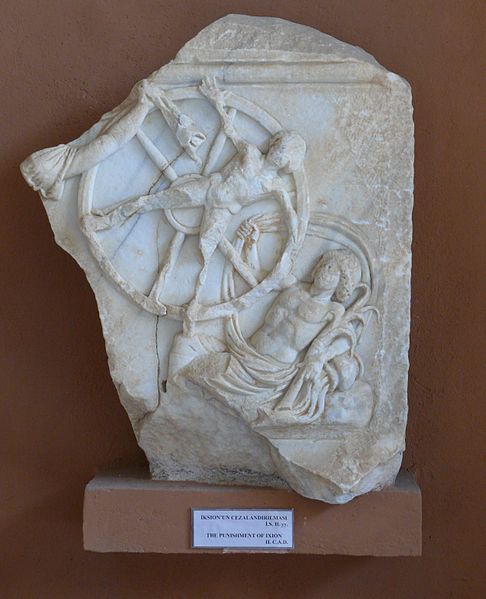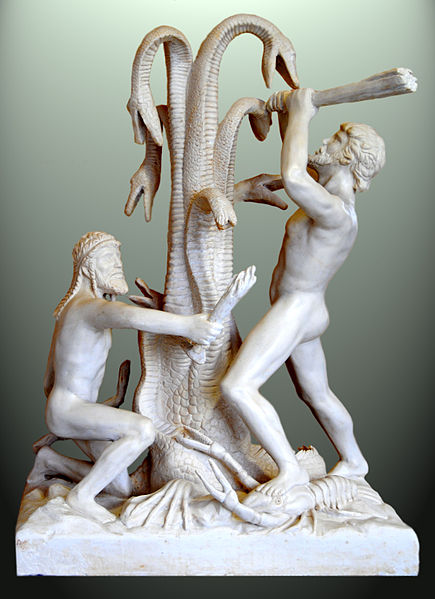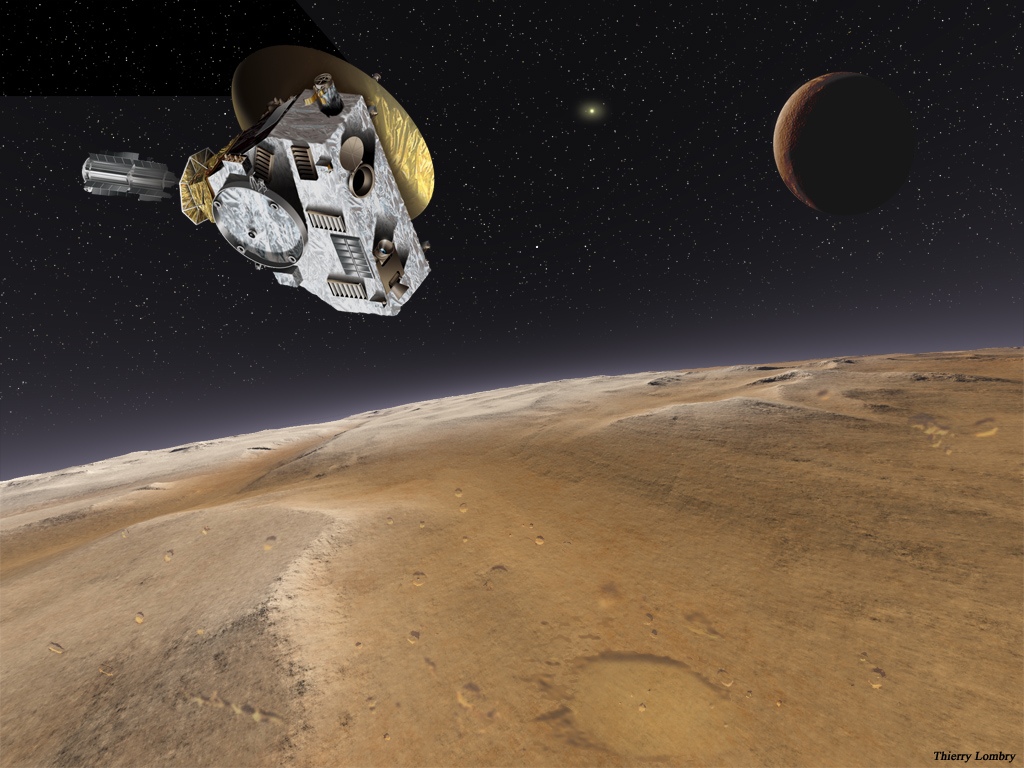In July, New Horizons will become the first spacecraft to explore the third zone of the solar system. It’s time we familiarize ourselves with this region of our home star! We know the classical planets’ names and their meanings, but what about the hundreds of newly discovered dwarf planets and thousands of smaller bodies out there beyond Neptune? So far only a handful have been named, and their names are fascinating. This is the first of a two-part series exploring this topic.
The Underworld Gathers

Pluto

Pluto was discovered in 1930. An 11 year old girl living south of London, Venetia Burney, heard the news at the breakfast table and suggested, “They could name it Pluto” [1]. The darkness around the distant planet reminded her of the dark Underworld in Greek mythology. What a difference one sentence from a child can make! Her grandfather loved the name and sent a telegram across the ocean to the Lowell Observatory (where the planet was discovered), and the astronomers there loved it, too. Ever since then the Underworld has been gathering in the Kuiper Belt. So if you visit the Kuiper Belt, be sure to dress appropriately. It’s cool to go as a member of the Underworld like Asajj Ventress or Ronan the Accuser, but dressing as Elsa or Barney would be a mistake.
Charon
The second body discovered in the Kuiper Belt is Pluto’s largest moon, or perhaps its binary partner. Jim Christy, the discoverer, decided to name it after his girlfriend Char (short for Charlene) and appended the –on just to make it sound more sciencey. (True story.) Completely unknown to Christy at the time – and to his great surprise – Charon is the name of an Underworld figure, the ferryman who takes departed souls across the river Styx into Pluto’s realm. It was perfect. It’s going to be an Underworld party in the Kuiper Belt!
Rhadamanthus
Rhadamanthus is likely too small to be a dwarf planet. It was named for a mythological king of Crete, a demi-god born of Zeus and the mortal woman Europa. Homer said he dwelt after his death in the Elysian Fields, a paradise on the western edge of the world, but later writers made him one of the judges of the dead in the Underworld.
Ixion

© Ad Meskens / Wikimedia Commons, Used by permission.
Judging by its brightness, Ixion is probably large enough to be a dwarf planet. It is classified dynamically as a plutino, meaning that every time Neptune goes around the sun thrice, Ixion goes around it twice, just like Pluto. This is a stable type of orbit so Neptune doesn’t fling plutinos out of the Kuiper Belt. (At one time, astronomers thought that Rhadamanthus was a plutino, too, but more precise analysis says that it isn’t.)
In Greek mythology, Ixion was not a god, but was a king like Rhadamanthius. While upright king Rhadamanthius got into the Underworld by being good, evil king Ixion got there by being bad. He tried to take the wife of Zeus and unwittingly fathered the race of Centaurs. For punishment he was bound forever to a flying, flaming, spinning wheel. Ouch. The later myths say this wheel is flying in the depths of Tartarus, part of the Underworld.
Nowadays, centaurs are small bodies that orbit in the zone of the giant planets, Jupiter through Neptune. The centaurs’ orbits are unstable because the gas giants will absorb them or fling them far away, usually within a few million years. Simulations tell us that one new centaur must arrive in this zone from the Kuiper Belt every 125 years (or so) to maintain the observed population. Therefore, bodies in the Kuiper Belt like Ixion really are fathering the centaurs. However, if you see Ixion floating around the Underworld party on his flaming, spinnng wheel, you probably shouldn’t mention the centaurs to him. He is still a bit sensitive about the subject.
Typhon and Echidna
Typhon and Echidna are small solar system bodies and a binary pair. Although they cross the orbits of Uranus and Neptune like centaurs, they also swing to the farther parts of the Kuiper Belt so they are classified as scattered disc objects (SDOs). Typhon, whose father was a personification of Tartarus itself, was the most terrible of monsters in Greek mythology. He was as tall as the stars, had a hundred dragon heads and shot fire from his eyes – oh, I can’t go on, it’s just too terrible. At first Typhon defeated Zeus and ripped all the cartilage from his body. Yikes. But Zeus recovered and trapped Typhon under a volcano where he keeps himself busy doing crafts with molten rock. Typhon had married the half-woman, half-serpent Echidna, who was his half-sister by the same dad. Together, Typhon and Echidna had lots of monstrous children. Doubtless they will be at the Underworld party, so if you value your cartilage, mind your manners when you meet them.
Orcus and Vanth
Orcus is almost certainly a dwarf planet. Dynamically it is a plutino along with Ixion and Pluto but with a unique feature: when Pluto is closest to the sun, then Orcus is always farthest from the sun, and vice versa. For this reason, Orcus is considered to be the Anti-Pluto. Orcus is the name of the Etruscan version of Pluto.
Orcas’ moon might be a dwarf planet, too. Naming it was put to a public vote by the discovery team’s leader Mike Brown. His blog’s readers picked Vanth: an Etruscan guide of the dead into Hades, somewhat like Charon but female. Thus, the anti-parallel with Pluto and Charon is complete.
I like the name Orcus the best out of the entire Kuiper Belt. I think it’s because Orcus sounds like orca, a killer whale. The similarity is not a coincidence; orca comes from the same root word as Orcus. We know this word in English today as ogre, a monster from Hades. J.R.R. Tolkien used the Anglo-Saxon version of the word, orc, for the race of goblins in The Hobbit and The Lord of the Rings. Whales were once thought to be monsters so they, too, were named orcs. Therefore, when you attend the Underworld Party, it would be appropriate to dress as a killer whale or an orc or the Great Goblin himself, but don’t go dressed as Legolas who killed orcs. That would be orcward.

Nix and Hydra
In 2005, two groups of researchers were looking at Pluto and discovered (at pretty nearly the same time) that it has two more moons in addition to Charon. Working together they came up with the names Nyx and Hydra. Their initials suggest the name New Horizons, a spacecraft that was already on its way to Pluto and is due to arrive this July.

Hydra was a many-headed snake-like monster in Greek mythology. It guarded the underwater entrance to the Underworld. Most of the myths say it had nine heads. Some astronomers argued against approving this name because nine sounded like a subversive attempt to say that Pluto is the ninth planet again! (We really are subversive like that, so don’t scoff.)
Nyx is the goddess of the night in Greek mythology. She was born of Chaos and lived in Tartarus in the depths of the Underworld. She was also the mother of Charon. The Latinized version of her name is Nox, from which we get the word nocturnal. The International Astronomical Union (IAU) agreed to these names except that Nyx was changed to Nix to avoid confusion with an asteroid of the same name. They reported that Nix is the “Egyptian spelling” of Nyx, but I can’t find evidence that the (Hellenistic) Egyptians spelled it that way. There is another report that it is actually the Spanish spelling. In any case, Nix in every language means that it’s nighttime in the Kuiper Belt, so party on.
Kerberos and Styx
In 2011 and 2012, two more moons of Pluto were discovered. Yes, my friends, the Pluto system is an amazing six body system, if not larger! The public was asked to choose names for these new moons through an Internet vote, and the top three choices were Vulcan, Cerberus, and Styx. The IAU disapproved the name Vulcan because it is already associated with the (disproven) planet Vulcan, and the (hypothesized) Vulcan asteroids close to the sun. The IAU changed the spelling of Cerberus from the Latin version to the original Greek Kerberos because the Latin already belonged to an asteroid. Styx was approved without change.

You will recall that the river Styx is the boundary of Hades in the Underworld, but it is also the goddess that rules over the same river. Kerberos is the three headed dog that keeps people from entering or exiting the Underworld by patrolling the river’s banks. Kerberos will remind Harry Potter fans of the three-headed dog named Fluffy that guarded the hatch to the Sorcerer’s Stone, a stone that allowed one to escape death. (J.K. Rowling knows her Greek mythology.) Maybe in the ultra-low gravity of Kerberos there will be a covering of snow and dust so that the moon actually is Fluffy. In any case, coming to an Underworld Party dressed as one of the more sinister Harry Potter characters would be the bomb.
So many Underworld names! But this is not entirely coincidence. Following the lead of young Venetia Burney, the IAU made it policy to use Underworld names for plutinos (and so the moons of plutinos will be named for the Underworld, too).
Huya
Huya is a plutino discovered by Venezuelan astronomers who proposed the name Juyá from the indigenous Wayuu culture of that region. (The IAU changed the spelling to Huya.) According to everything I could find, Juyá isn’t an Underworld being in Wayuu mythology but is rather a rain god – a phenomenon that happens above the Earth, not beneath it. The Minor Planet Center Circular that assigned the name says,
Huya is one of the most representative gods in the infra-world [underworld] of the Wayuu Indians of Venezuela. As such it is associated with the rain and winter, and lives in the celestial altitudes beyond the sun.
I was confused when I read this, but after some reflection I think I understand. Apparently the Wayuu do not have a concept of an Underworld similar to that of the Greeks or Romans, and I’m guessing the closest analog they have to the cold, dark halls of Hades would be the shadowy underwater world and the coldness of winter. Thus, Huya being a rain god and associated with winter is “one of the most representative gods” of the Underworld – i.e., the best analog from that culture. Since the IAU’s objective in choosing the naming themes wasn’t to omit cultures from the Kuiper Belt but rather to celebrate their diversity, including Huya as the Wayuu interpretation of the Underworld contributes to this fascinating tapestry. Welcome to the Underworld party, Huya!
Friends of the Underworld
There are a lot more bodies out there in the Kuiper Belt with names that don’t have Underworld connections, and there are many more that aren’t named at all. However, I think a couple more guests should be invited to the Underworld party.
Eris and Disnomia
Eris and its moon Disnomia were discovered in 2003 and 2006, respectively, by Mike Brown and co-workers. Because Eris’ size rivaled that of Pluto, it precipitated the events leading to the IAU redefinition of a planet. That led to some strife and discord among astronomers, so Brown named this body after Eris, the Greek goddess of strife and discord, and its moon after Disnomia, the daemon of lawlessness. Eris is not a plutino, and neither Eris nor Disnomia are Underworld figures. The names don’t fit into some other theme of the outer solar system, either (see next post). That’s not surprising, since they are scattered disc objects where a naming convention has not been specified. So for now, Eris and Disnomia are lonely. But strife, discord and lawlessness fit the behavior of most Underworld supervillains, so I think they should be invited to the party. Don’t you?
Summary
So there is an Underworld party in the Kuiper Belt. New Horizons is about to send us the first close-up pictures from the party. Of the dozens of known plutinos, only four have been given Underworld names so far. There are six moons between them so that makes ten. Rhadamanthus has an Underworld name, too. To round out the party we invited two pairs of Scattered Disk Objects that have Underworld names (or at least some nominal connection to the Underworld). In the next post we will leave the party and look at two other naming themes out there in the far reaches of our most excellent solar system home.

| Name | Discovery Date | Naming Date | Dynamical Class | Geophysical Class | Mythological Role of its Namesake | Culture |
|---|---|---|---|---|---|---|
| Pluto | 1930 | 1930 | Plutino | Definitely Planet-size | The ruler of the Underworld | Greek |
| Charon | 1978 | 1978 | Moon or Binary | Surely Planet-size | Ferryman across the river Styx | Greek |
| Rhadamanthus | 1999 | 2002 | Cubewano | Small body | King of Crete and later judge of the dead in the Underworld | Greek |
| Ixion | 2001 | 2002 | Plutino | Probably Planet-size | King bound to a spinning wheel | Greek |
| Typhon | 2002 | 2006 | SDO | Small body | Terrible monster | Greek |
| Echidna | 2006 | 2006 | SDO | Small body | Half-woman/half-snake | Greek |
| Orcus | 2004 | 2004 | Plutino | Surely Planet-size | Ruler of the Underworld | Etruscan |
| Vanth | 2005 | 2010 | Moon | Possibly Planet-size | Guide to the dead into Hades | Etruscan |
| Nix | 2005 | 2006 | Moon | Small body | Goddess of the night | Greek |
| Hydra | 2005 | 2006 | Moon | Small body | Monster who guarded the entrance to the Underworld | Greek |
| Kerberos | 2011 | 2013 | Moon | Small body | Three-headed dog that guards the banks of the river Styx | Greek |
| Styx | 2012 | 2013 | Moon | Small body | Goddess of the Underworld river | Greek |
| Huya | 2000 | 2003 | Plutino | Possibly Planet-size | Rain god | Wayuu |
| Eris | 2003 | 2006 | SDO | Definitely Planet-size | Goddess (and personification) of Strife and Discord | Greek |
| Disnomia | 2005 | 2006 | Moon | Small body | Daemon (and personification) of Lawlessness | Greek |
Footnotes: [1] Schilling, Govert. The Hunt For Planet X: New Worlds and the Fate of Pluto. Springer Science & Business Media, 2010., p. 37. [2] SDO = Scattered Disc Object
This post was modified by adding Huya and by updating the graph at the end.

